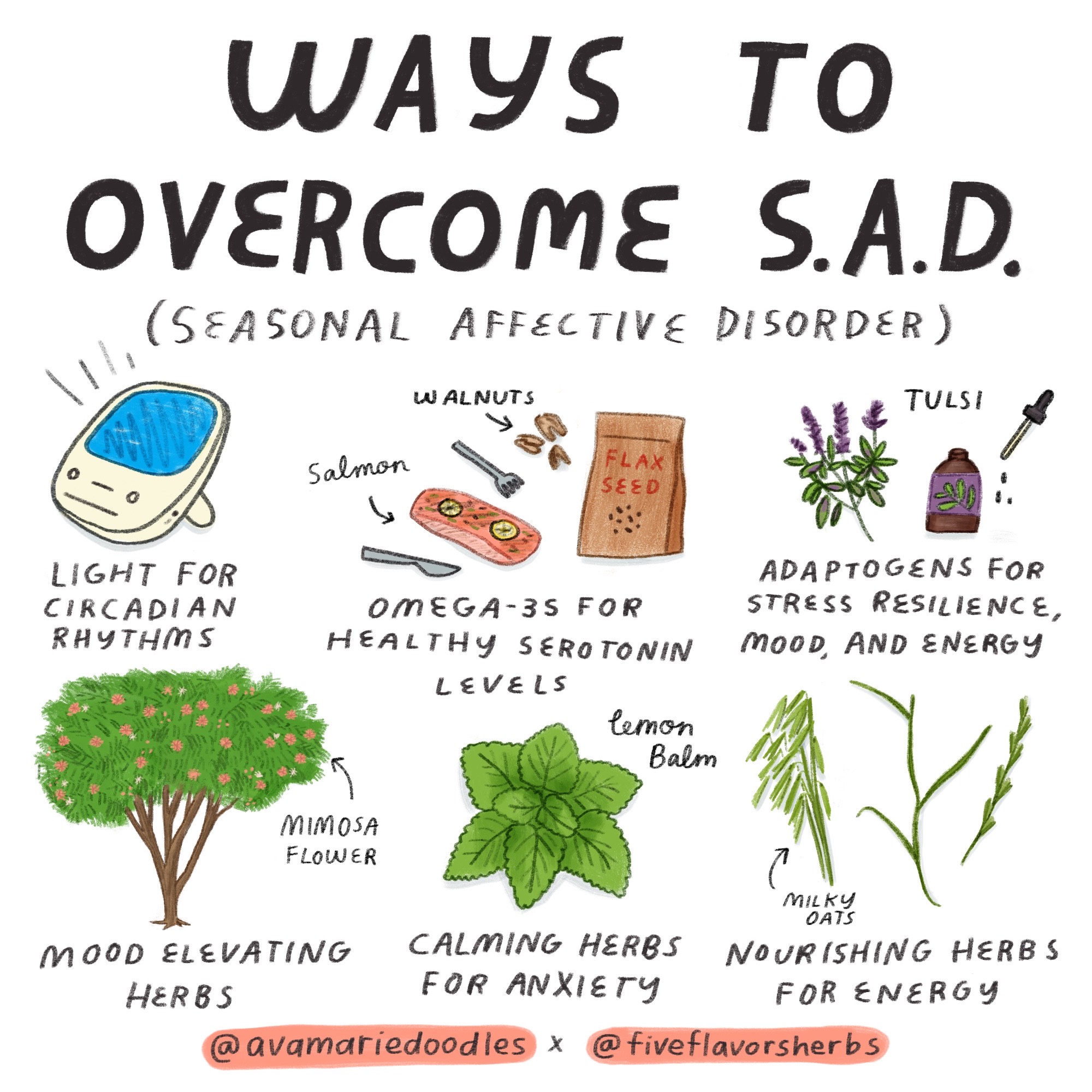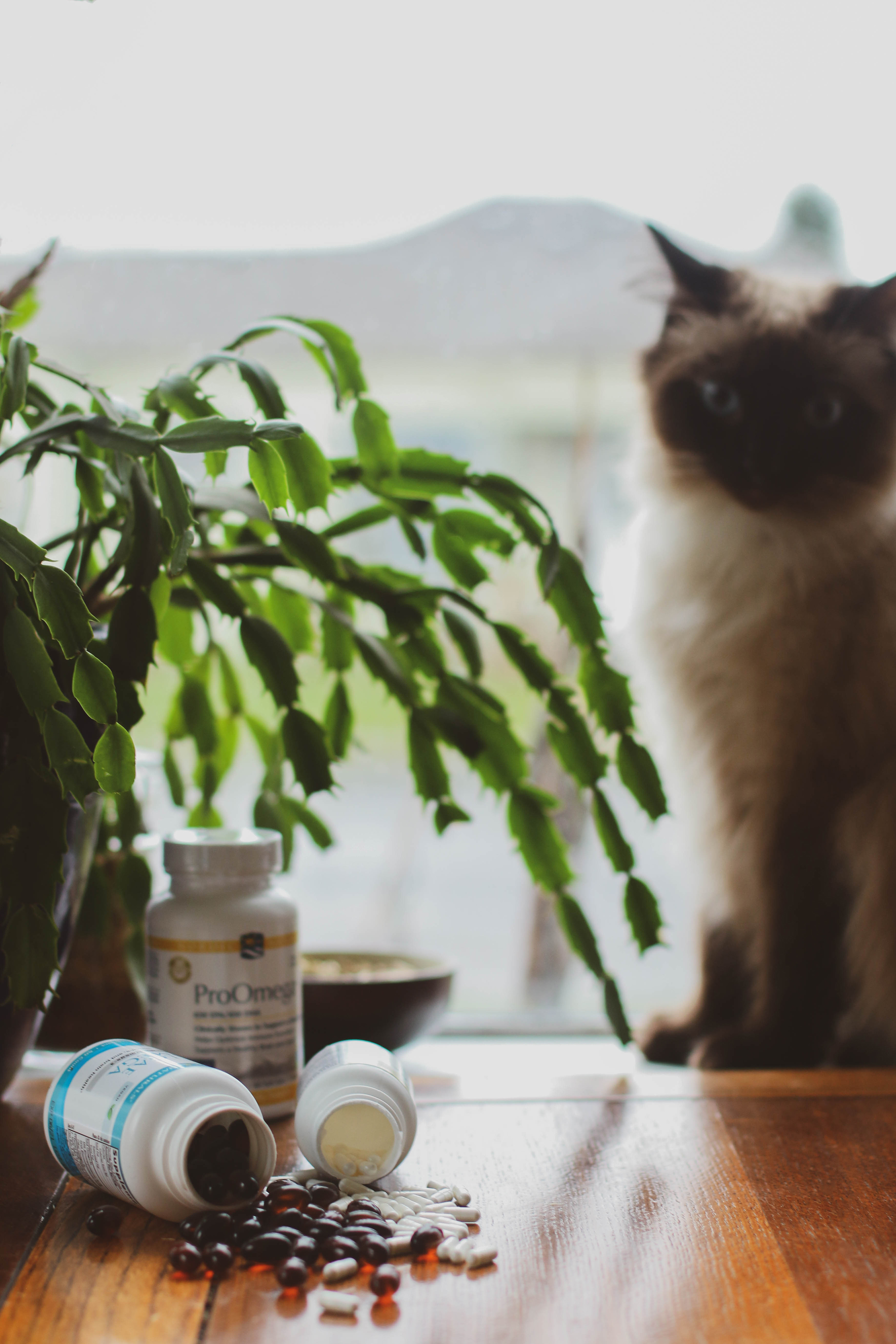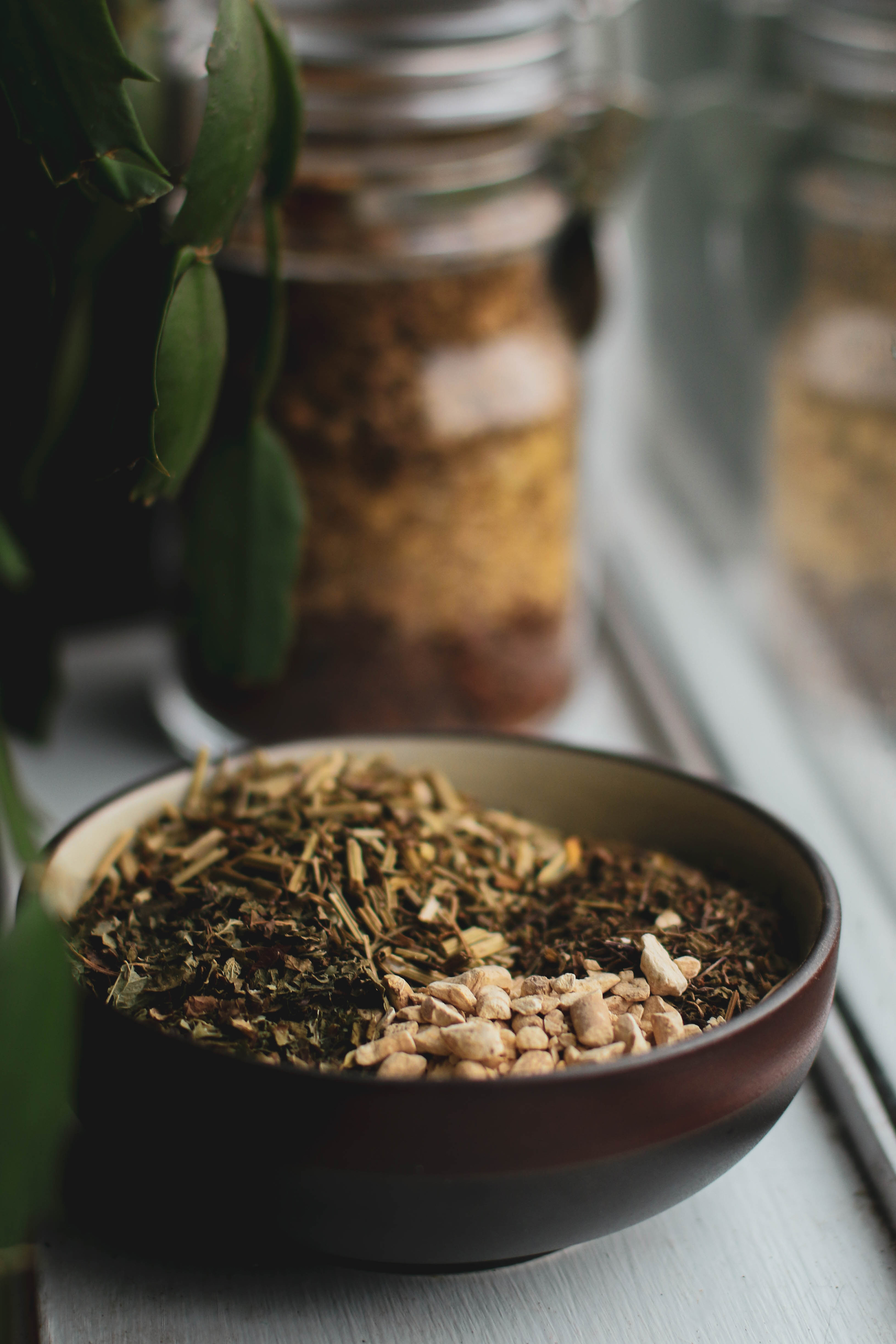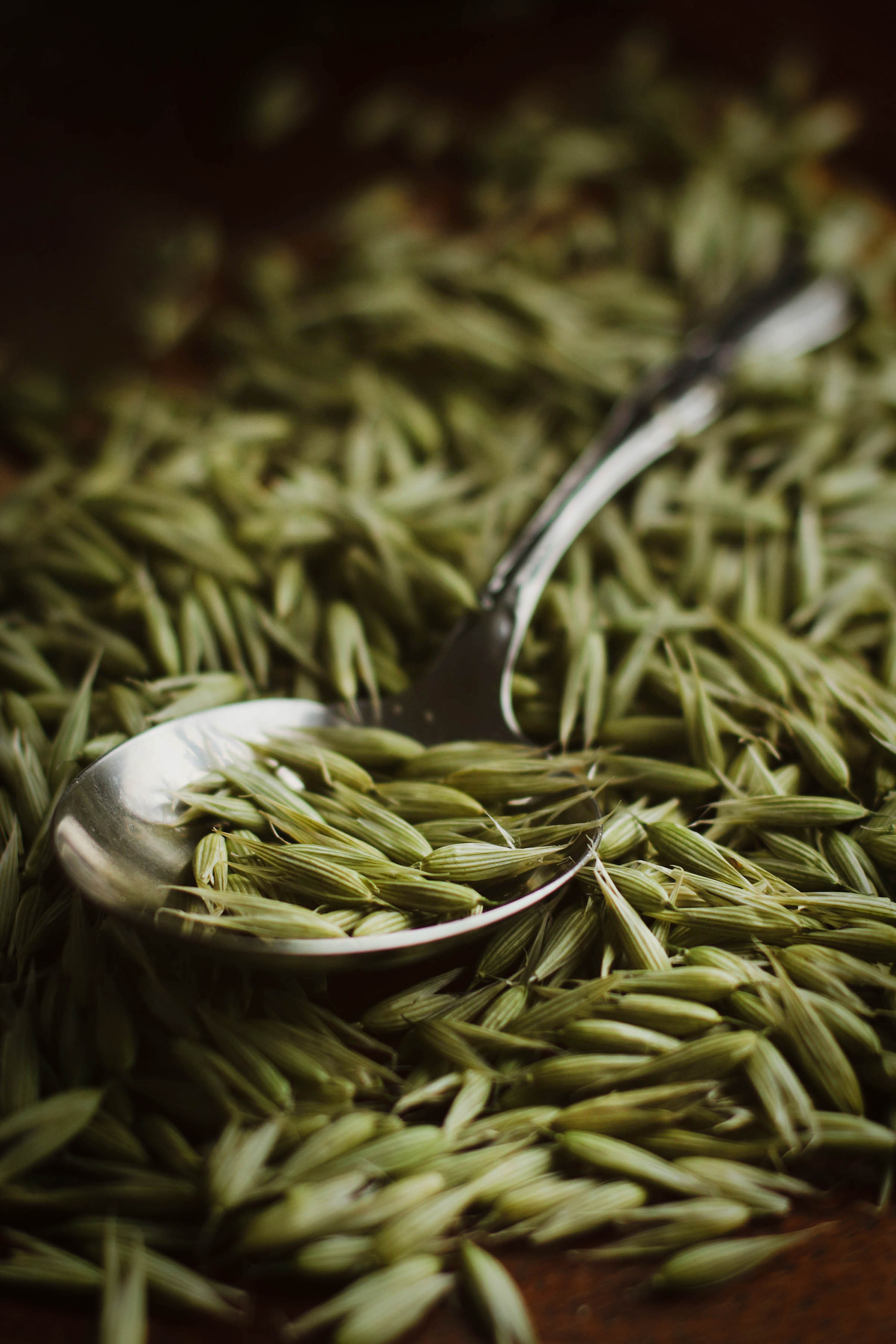The short, cold days of winter can be hard, especially when they come at the end of an exhausting and devastating year. The weather, the darkness, and slowness of the season can give rise to a state of pronounced winter blueness officially classified as “Seasonal Affective Disorder.” Also known by its appropriate acronym, SAD, this state of seasonal depression has long been recognized by peoples across the world (especially those furthest from the equator), leading to a variety of cultural strategies for combating it. More recently, mental health researchers have sought effective remedies for SAD, and we now have a mix of traditional and modern measures to support the mood when temperatures fall.
Causes & Symptoms of Seasonal Affective Disorder
While many forms of mood imbalance persist year-round, Seasonal Affective Disorder is a specific variation associated with the winter months (though rarely, folks may experience this form of seasonal depression in the spring or summer). SAD leads to many of the classic signs and symptoms of clinical depression, including low mood, disinterest in activities that usually bring pleasure, loss of interest in sex, loss of appetite, lack of energy or concentration, disrupted sleep, and feelings of guilt or worthlessness. Epidemiologic studies suggest that among the general population in the Northern Hemisphere, 0.5% to 10% of individuals experience SAD, while 15% of individuals with pre-existing depression experience SAD. Proposed causes of SAD include disruptions in circadian rhythms (due to shorter days and longer nights) that lead to overproduction of melatonin, genetic predisposition, abnormal serotonin activity, and low vitamin D levels. The exact mechanism, however, is not well understood by medical science, but these studies have provided some clues for mitigating SAD’s effects.
Winter Mood Imbalances in Traditional Chinese Medicine
In Traditional Chinese Medicine, winter is associated with the Water element and yin energy. The season’s positive attributes include a tendency towards rest, introspection, and adaptability. When out of balance, these energies can move us towards self-isolation, fear, and indecision. Common feelings during the winter months include worry, anger, grief, hopelessness, darkness, frustration, regret, and guilt—and for many, these internal struggles have been greatly exacerbated by a difficult year of global confinement, outrage, and loss.
TCM offers a combination of nutritional and behavioral guidance for dealing with winter-related mood conditions. Foods classified as “salty” according to the five flavors of Chinese medicine provide the body with the properties of Water. Water energy is said to purge and move stagnation, guide vital energy (or qi) to the Kidneys, and promote vitality and resilience. Salty winter foods like hearty soups, meats, whole grains, and roasted nuts nourish and warm our bodies, helping us adapt to the energy of the season. Variations on classic TCM formulations with salty ingredients, such as Chai Hu Jia Long Gu Mu Li Tang Plus Tincture for combating frustration and despair, may help resolve energy imbalances linked to seasonal shifts. Chinese medicine also recommends working with nature’s rhythms by keeping a regular sleep schedule, staying warm, and minimizing stress to free up the body’s energy to defend itself against the taxing influences of the cold and dark months.
Natural Support for Seasonal Affective Disorder
Between light, movement, mindfulness, herbs and supplements, here are some of our favorite strategies to return to brightness, hope, and optimism:
LIGHT THERAPY TO RESET RHYTHM
Our bodies need natural light to function properly, but cold or wet weather and 9-to-5+ work schedules keep many of us inside during winter’s few daylight hours. Luckily, we can use light therapy lamps to reduce this deficit.
Phototherapy is a well-accepted therapy for seasonal and other mood disorders. Blue light at 10,000 lux filters out damaging UV rays while exposing us to parts of the spectrum that can help reset our circadian rhythms, improving mood and energy. For best effects, get 30 to 45 minutes of exposure in the morning.
TALK THERAPY FOR PERSPECTIVE
Often, a good way to break the cycle of depressive thoughts is to explore them with someone outside your own head. Whether you confide in a close friend or family member or engage with a psychotherapist, talking about your SAD emotions can help you process your frustration with yourself and the winter season.
While social support from those close to you carries its own unique set of benefits, professional guidance can help lead you through structured types of psychotherapy, such as cognitive behavioral therapy (CBT), which helps train your brain to create more positive thought patterns and has been shown to benefit SAD.
MOVEMENT FOR BETTER MOOD
Getting outside into the light, even if it is overcast or raining/snowing, can be as helpful as light therapy, and even more so if it involves movement. Brisk cardiovascular exercise activates endorphins that create a sense of well-being and positivity. So whenever possible, throw on that coat and get outside!
If the weather is just too awful, or you can’t risk slipping on the ice, indoor activities like dancing, yoga, lovemaking, stationary biking, and tumbling around with your pets and/or kids are great alternatives!
VITAMIN D FOR HORMONE BALANCE
Also known as the “sunshine vitamin,” vitamin D is a naturally occurring neurosteroid hormone that plays many critical roles in maintaining our physical and mental health. It helps regulate cell function, reduces inflammation, and supports healthy hormone production across the hypothalamic-pituitary-adrenal (HPA) axis.
Vitamin D is normally produced by our bodies when our skin is exposed to natural sunlight. Between an indoor lifestyle and short dark days, vitamin D deficiency is all too common, especially during the winter months. Vitamin D levels are inversely associated with depression, and supplementing vitamin D in those with low levels may help improve mood symptoms.
You can get a daily dose of Vitamin D with high-quality capsules, serums, and even gummies. It is also naturally found in egg yolks, mushrooms, and some fish (the more naturally raised, the better!).
OMEGA-3 FATTY ACIDS FOR NOURISHMENT
Omega-3 fatty acids (ALA, DHA, and EPA) are critical elements to health that are missing in many modern diets.
Omega-3s play a role in cardiovascular health, eye health, brain development in babies, and prevention of Alzheimer's in the elderly, and they may exert anti-inflammatory benefits throughout the body as well. Many studies have found associations between omega-3 deficiencies and depressive disorders. While scientific findings differ as to the benefit of omega-3s for treating clinical depression, a recent meta-analysis suggests a significant improvement in mood symptoms when EPA-rich formulations are used. This may be especially important in seasonal mood changes, where levels of inflammatory fatty acids may be higher, and EPA-containing supplements may improve mood symptoms by reducing reducing oxidative stress.
Fatty fish, nuts (walnuts), seaweed, seeds (flax, chia, pumpkin, hemp), and soybeans and all good sources of these essential nutrients. Omega-3 fish oil-based and algae-based vegan omega-3 supplements are also available.
MOOD-SUPPORT HERBS for the BLUES
The plant world offers many ways to support vitality and lift the mood throughout the seasons. In addition to light, movement, and vitamin D and omega-3 supplementation, incorporating herbal tinctures and/or teas can help lift the mood, clear the mind, spark energy, and warm the body. Many of these plants contain natural substances that can help our brains produce and use mood-balancing chemicals like serotonin, dopamine, norepinephrine, and GABA. These herbs include adaptogens (which balance and energize), or different types of nervines (which calm, soothe, and nourish the nervous system).
ADAPTOGENS: Adaptogenic herbs improve the body’s response to stress, lift the mood, and improve mental and athletic performance. These herbs can be used in the short-term to override exhaustion and push through stressful situations, or taken tonically to support rest and relaxation and balance energy and mood. Two of my favorites are ashwagandha and rhodiola.
- Ashwagandha (Withania somnifera), a member of the nightshade family, has been used in Ayurvedic and Unani medicine for millennia as “rasayana” (rejuvenator) for a plethora of applications, including insomnia, debility, infertility, skin and digestive conditions, and many kinds of infections. It is soothing and nourishing to the nervous system, gentle enough to be taken before bed (the traditional method) but not so sedating it can’t be taken during the day to support a healthy stress response.
- Rhodiola (R. rosea), a crassulaceous plant native to cold, harsh climates from Tibet, to Siberia, to Scandinavia, has been used cross-culturally to promote endurance, longevity, and positive mood for millenia. In vitro and animal studies suggest that rhodiola rhizome stimulates noradrenaline, serotonin, dopamine, and acethycholine receptors in the brain, increases serotonin by inhibiting MAO enzymes, and increases endogenous endorphins. One small human trial suggests moderate improvement in depressive symptoms with rhodiola extract.
NERVINES: Nervine herbs act in a variety of ways to relax and soothe the body, calm the mind, support rest, and generally nervous system. These balancing effects can aid us in overcoming mood conditions. Here are some helpful nervine botanicals of different varieties:
Uplifting Nervines
- Albizia (A. julibrissin, aka mimosa tree) has a long history of use in Traditional Chinese and Persian medicines for mood disorders, insomnia, and anxiety. Its name loosely translates to “collective happiness tree.” Very little scientific research is published in English on its pharmacology or mechanisms, but many herbalists in North America (including us) have been using extracts of the bark and flower to support the mood and calm the mind for decades.
- St. John’s wort (Hypericum perforatum) also has an extensive history of medicinal applications, dating back to at least the ancient Greeks, who used it for wounds, burns, stomach ulcers, depression, and nerve pain. Traditionally harvested in peak flower near the Summer Solstice, these sunny blossoms remind us of the sun, which can be symbolically and energetically helpful during the winter. Unlike albizia, St. John's wort is one of the most researched and consumed botanicals for lifting the mood. Among many phytochemicals, hypericin and hyperforin are two well-understood components that have been shown to increase neurotransmitter levels and reduce cortisol levels. Systemic reviews and meta-analyses have confirmed the benefit of St. John’s wort in treating clinical depression (compared with placebo and antidepressants). You should consult a physician before using St. John’s wort internally if you take prescription medications, but topical and homeopathic preparations don’t usually present a risk for interactions.
Calming Nervines
- Lemon balm (Melissa officinalis) is a bright, calming member of the mint family that’s great medicine for the whole family. Easy to grow almost anywhere, the leaves taste delicious in tea or as a glycerite alcohol-free extract for soothing upset stomachs, breaking a sweat, and calming the mind without being overly sedating. Animal studies demonstrate anti-depressant effects through a tendency to increase serotonin and norepinephrine, and small human trials suggest benefits in treating mood symptoms.
- California poppy (Eschscholzia californica) sits further along the sedating spectrum of nervines. It can be used to support healthy sleep, to relieve minor aches, and to quell nervous rumination of the mind. It is downright bitter due to its alkaloid content, so we recommend consuming it as a tincture (diluted in warm water, if desired), a glycerite, or in capsule form—it doesn’t make for a great cup of tea! Those alkaloids are well worth it though, as they are believed to influence GABA receptors, as well as serotonin and noradrenaline reuptake transporters, hinting at why California poppy is so beneficial for improving mood and calming anxiety.
Nourishing Nervines
- Milky oats (Avena sp.) aren’t just good nutrition for your body, but for feeding your nervous system as well. The green seed heads picked when the grain is just forming produce a milky sap when squeezed (hence their name). Milky oats have long been used in European and North American herbal traditions to support recuperation from physical and emotional illness, calm anxiety, and curb cravings. Active constituents include essential fatty acids and beta-glucans, tocopherols, flavonoids, and avenanthramides. The latter, avenanthramides, have strong antioxidant properties that may prove beneficial in the prevention and treatment of neurodegenerative and cardiovascular diseases.
- Bone broth isn’t a plant, but in Traditional Chinese Medicine, “herb” refers to any medicinal substance: animal, mineral, or vegetable. Rich in collagen, gelatin, and essential nutrients such as calcium, iron, magnesium and potassium, bone broths are used as healing, nourishing remedies around the world. In TCM, mineral-rich bones and shells are used to calm the mind and lift the mood, as in Chai Hu Long Gu Mu Li Tang. Since poor eating habits are such a common symptom of SAD, bone broth, whether alone or as a soup stock, can be a great way to reset the digestion and improve eating habits.
Warming Nervines
Cold weather and inactivity can lead to stagnation in the body and mind, so using warming, stimulating herbs such as cinnamon, ginger, and orange peel can give you the lift you need to get going! These herbs can be enjoyed in a spiced elderberry syrup, a digestive support tincture, an immune-supporting fire cider, or in a hot cup of tea after coming in from a vigorous winter walk to warm the extremities.
Getting Help for SAD
If you or someone you know experiences seasonal mood swings, prevention is the best medicine! Start making healthy choices around food and exercise as early as possible, and incorporate adequate vitamin D and omega-3 fatty acids into your regimen as the days get shorter. Consider exploring plant allies to support your mood, and if you feel stuck, consult an herbalist.
If your SAD symptoms become intense, don’t hesitate to reach out for help! If you or someone you know is in immediate distress or is thinking about hurting themselves, call the National Suicide Prevention Lifeline toll-free at 1-800-273-TALK (8255) or the toll-free TTY number at 1-800-799-4TTY (4889). You also can text the Crisis Text Line (HELLO to 741741) or go to the National Suicide Prevention Lifeline website.
We wish you a healthy and restorative winter, with hope for spring’s renewal to come!
You might also enjoy:
You might also enjoy:
- Adapting to Stress: Natural tools for Resilience
- Herbal Tinctures for Natural Health Support
- Epic Bone Broth Recipes
Written by Ingrid Bauer, MD, MS: With experience that bridges Western and Eastern medicine, Ingrid brings rigorous scientific knowledge to Five Flavors Herbs. A graduate of the UC Berkeley/UCSF Joint Medical Program and the American School of Herbalism in Santa Cruz, CA, Ingrid integrates plant-based medicine into mainstream healthcare. She is passionate about bringing holistic care to people from all walks of life.







